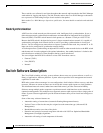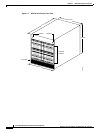
1-39
Cisco BPX 8600 Series Installation and Configuration
Release 9.3.10, Part Number 78-11603-01 Rev. D0, July 2001
Chapter 1 The BPX Switch: Functional Overview
Network Synchronization
Network Synchronization
Cisco WAN switching cell relay networks use a fault-tolerant network synchronization method of the
type recommended for Integrated Services Digital Network (ISDN). You can select any circuit line,
trunk, or an external clock input to provide a primary network clock. Any line can be configured as a
secondary clock source in the event that the primary clock source fails.
All nodes are equipped with a redundant, high-stability internal oscillator that meets Stratum 3 (BPX)
or Stratum 4 requirements. Each node keeps a map of the network's clocking hierarchy. The network
clock source is automatically switched in the event of failure of a clock source.
There is less likelihood of a loss of data resulting from re-frames that occur during a clock switchover
or other momentary disruption of network clocking with cell-based networks than there is with
traditional TDM networks. Data is held in buffers and packets are not sent until a trunk has regained
frame synchronism to prevent loss of data.
Virtual Trunk Clock Source Synchronization
The increasing use of Virtual Trunks in Wide Area Networks has led to the development of the Virtual
Trunk Clock Source Synchronization feature (VTCSS) in SWSW release 9.3.30. VTCSS operates
transparently making network synchronization to a single ATM service provider clock source
possible.(1)
When a virtual trunk port (VTP) is configured as a network clock source in pre-9.3.30 SWSW releases,
the first virtual trunk (VT) interfaced on that VTP becomes the clock source by default. If the first VT
fails, the clock source is automatically switched to the next available clock source (2) exclusive of the
VTP that the failed VT was interfaced with.
With the VTCSS feature, if the first VT on a clock configured VTP fails, the clock source is switched
to the next VT interfaced on that VTP. If the second VT fails the clock source is switched to the next
VT interfaced on the same VTP and so on. As a result, the clock source remains associated with the
physical interface (clock configured VTP) as long as there are one or more active VTs interfaced on
it.(3)
The VTCSS feature is here is no configuration
1. May not allow all nodes in the network to synch. to the same clock source...may just allow a network
to achieve a higher degree of clock synchronization than was previously possible.
2.As defined by the network system software.
3. If one VT on a VTP is configured: pass synch = yes, that VTP can’tbeaclocksourceinthefirst
place. Do I need to mention that in the scope of this doc?
4. Do I need to mention the debug on/off flag, or is this beyond the scope of the BPX Installation &
Configuration Guide?
as the clock source., even though the physical interface of the Virtual interface is active and there are
other active VT’s available to switch to.


















